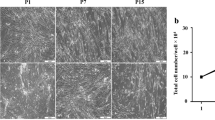Abstract
To investigate the infection and replication of hepatitis B virus (HBV) in primary cultured human granulosa cells. Human granulosa cells were cultured with HBV-positive serum. Media were collected and assayed for HBsAg and HBeAg by ELISA, and HBV DNA by quantitative PCR. HBsAg and HBcAg were detected by immunocytochemistry in cultured cells. HBV DNA and RNA were extracted and amplified by nested PCR. Intracellular HBV DNA was localized by in situ hybridization. By co-cultivation of human GCs with HBV-positive serum, a system was established to study HBV infection and replication in GCs. HBsAg in medium could be detected from 4 to 96 h, and HBV DNA could be detected from 12 to 96 h after exposure. HBsAg and HBcAg showed positive signals by immunocytochemistry. A 206-bp fragment was amplified by nested PCR to detect HBV DNA and RNA in granulosa cells. HBV DNA was detected in GC nuclei by in situ hybridization. HBV can infect and replicate in human primary granulosa cells. This culture system could enable us to study infection of ova by HBV.







Similar content being viewed by others
References
Ye F, Yue Y, Li S, Chen T, Bai G, Zhang S et al (2006) Presence of HBsAg, HBeAg, and HBV DNA in ovary and ovum of the Patients with chronie hepatitis B virus infection. Am J Obstet Gynecol 194:387–392
Chen LZ, Fan XG, Gao JM (2005) Detection of HBsAg, HBcAg, and HBV DNA in ovarian tissues from patients with HBV infection. World J Gastroenterol 11:5565–5567
Eppig JJ (1991) Intercommunication between mammalian oocytes and companion somatic cells. Bioessays 13:569–574
Sifer C, Bénifla JL, Bringuier AF et al (2002) Could induced apoptosis of human granulosa cells predict in vitro fertilization–embryo transfer outcome? A preliminary study of 25 women. Eur J Obstet Gynecol Reprod Biol 103:150–153
Fujino K, Yamashita Y, Hayashi A, Asano M, Morishima S, Ohmichi M (2008) Survivin gene expression in granulosa cells from infertile patients undergoing in vitro fertilization-embryo transfer. Fertil Steril 89:60–65
Fei YL, Yue C, Li L, Yi Y et al (2009) Preliminary study on genotype of hepatitis B virus detected from Xinjiang Uygur Autonomous Region in China [J]. Zhonghua Shi Yan He Lin Chuang Bing Du Xue Za Zhi 23(5):346–348
Gripon P, Rumin S, Urban S et al (2002) Infection of a human hepatoma cell line by hepatitis B virus. Proc Natl Acad Sci USA 99:15655–15660
Lin Min, Chen Qun, Yang Li-Ye et al (2007) Hepatitis B virus infection and replication in primarily cultured human fetal hepatocytes. World J Gastroenterol 13:1027–1031
Wang AH, Wang AQ, Xu DZ et al (2008) The mechanism of HBV infection of human trophoblast cell. Zhonghua Shi Yan He Lin Chuang Za Zhi 22:51–53
Li F, Wang X, Men K, Xu D, Yan Y, Zhang J (2007) Receptivity of human choriocarcinoma JEGIII cells and isolated trophoblast cells to hepatitis B virus infection and enhancement by tumor necrosis factor alpha. Jpn Infect Dis 60:167–172
Bai H, Zhang L, Ma L, Dou XG, Feng GH, Zhao GZ (2007) Relationship of hepatitis B virus infection of placental barrier and hepatitis B virus intra-uterine transmission mechanism. World J Gastroenterol 13:3625–3630
Ali BA, Huang TH, Salem HH, Xie QD (2006) Expression of hepatitis B virus genes in early embryonic cells originated from hamster ova and human spermatozoa transfected with the complete viral genome. Asian J Androl 8(3):273–279
Chen HY, Shen D, Wang SH et al (2002) Detection on presence of hepatitis B virus in human infected by vertical transmission. China Public Health 18:417–419
Zhou SL (1989) Detection of HBVDNA in oocyte of a patient with chronic hepatitis B by in situ by hybridization. J Hered Dis 6:46–48
Taylor PJ, Gill MJ, Mahadevan M, Pattinson HA (1989) Hepatitis B virus in follicular fluid. Fertil Steril 48:54–56
Huang TH, Zhang QJ, Xie QD, Zeng LP, Zeng XF (2005) Presence and integration of HBV DNA in mouse oocytes. World J Gastroenterol 11(19):2869–2873
Fair T (2003) Follicular oocyte growth and acquisition of developmental competence. Anim Reprod Sci 15(78):203–216
Singh AE, Plitt SS, Osiowy C et al (2010) Factors associated with vaccine failure and vertical transmission of hepatitis B among a cohort of Canadian mothers and infants. J Viral Hepat (Epub ahead of print)
Acknowledgment
Supported by the National Natural Science Foundation of China, No. 30371277
Author information
Authors and Affiliations
Corresponding author
Rights and permissions
About this article
Cite this article
Jin, Y., Ye, F., Shi, J. et al. Hepatitis B virus infection and replication in primary cultured human granulosa cells. Arch Virol 156, 1–7 (2011). https://doi.org/10.1007/s00705-010-0808-8
Received:
Accepted:
Published:
Issue Date:
DOI: https://doi.org/10.1007/s00705-010-0808-8




